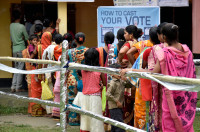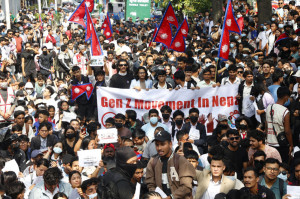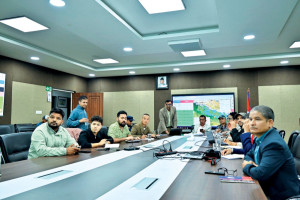Opinion
A burning issue
Women’s health does not simply comprise maternity and reproductive health; acute respiratory infections are also an occupational hazard
Anita Karki
Every year, 4.3 million deaths are attributable to household air pollution and 3.7 million deaths to outdoor air pollution, according to the World Health Organisation. Other equally alarming facts are now being shared, such as 1 million children under five losing their life every year due to air pollution, 1.6 million people dying in developing countries due to indoor air pollution, and indoor and outdoor pollution killing more people in a year than malaria and AIDS combined.
Cooking illness
It is also said that household air pollution from cookstove smoke is equivalent to smoking 400 cigarettes an hour. I am struck by the warning of the Global Alliance of Improved Cook Stoves: “Cooking kills! It should not but this is precisely what is happening!” Acute Respiratory Infection (ARI) has been identified as one of the leading causes of deaths and morbidity across the globe. Pollutants from the domestic biomass fuel (wood, cow dung, etc) used in traditional cookstoves have been identified as major sources of indoor air pollution responsible for ARI. It might not be too far-fetched if traditional stoves began to display a note of warning: ‘Cooking kills’, just like cigarette packs display the warning ‘Smoking kills’.
As early as 2000, WHO categorised cooking as a dangerous occupation since indoor air pollution from cooking on traditional cookstoves posed one of the top ten global health risks. A decade ago, the organisation reported that women were at much higher risk and faced a higher incidence of deaths from Chronic Obstructive Pulmonary Disease (COPD) worldwide because of soot from indoor smoke depositing in their lungs. COPD is a term used to describe chronic lung diseases like bronchitis and asthma, which, for many of us, is just an old age condition. It is a fact that women and their infants spend considerably longer time around a cook stove than men. However, this problem has not been emphasised in the Millennium Development Goals, national development plans and programmes, or health programmes and policies.
In Nepal, 81 percent of households still rely on biomass fuel for everyday cooking. Almost 75 percent of households cook indoors and almost 90-95 percent of these cook on an open fire. These households have a long way to go before they can access electricity or Liquefied Petroleum Gas as cooking options. Their immediate and feasible solution ends up being something as simple as Improved Cook Stoves (ICS) or a biogas plant.
Improving on stoves
Improved cookstoves have been part and parcel of rural development in Nepal since the 1950’s. Distributed with the goal of saving forests, protecting the environment, and to a certain extent, for health reasons, improved cookstoves, like toilets built by sanitation projects, have been an entry pass into the community for various development projects. Occasionally some ‘gender-related activity’ is integrated in such projects. But these approaches have not shown sustainable results. Improved cookstoves have never completely replaced traditional cookstoves. Moreover, ‘improved’ cookstoves have not been improved over time, in that communities have not gained access to newer and better technology.
In keeping with global initiatives, the government plans to install improved cooking stoves throughout Nepal by 2017. On January 20, 2013, the Government of Nepal announced an ambitious mission of ‘Clean Cooking Solutions for All by 2017’ (CCS4ALL). The government has requested all concerned stakeholders to recognise that achieving this mission requires stronger collaboration. We do not have to start from zero, because many NGOs and INGOs are already involved in ICS projects, and forums, workshops and seminars on the subject are being held every now and then.
Indeed, what is needed is strong political will at the national and local levels, a concerted effort from related stakeholders, as well as inter-linkages between policies and programmes of all sectors and line agencies. The health sector has a crucial role to play in this regard, as the issue of air pollution no longer remains just an environmental concern but also a health concern requiring immediate attention.
Better prevention than cure
The environmental health and hygiene programme has been part of the five-year health strategy of the National Health Sector Support Programme under the Ministry of Health and Population. Although the programme mentions acute respiratory infections (ARIs) and diarrheal disease as the leading causes of child death, at the implementation level, it is focused on water and sanitation-related diseases and mentions improving water quality as a preventive measure. The strategy does not relate ARI to air pollution, and thus, puts emphasis on care instead of on real preventive measures. The 2010/11 health service coverage fact sheet showed that the incidence of ARI per 1,000 children under five years was 882, which is much higher than the incidence of diarrhea for the same sample size, ie, 500.
Studies on the impact of indoor air pollution have also suggested that indoor air pollution results in still births and low birth weights. While setting its awareness-building agenda, the health sector should recognise that it is imperative to spread awareness about the hazards of indoor air pollution for the care of pregnant women and newborns. This should be an essential component of the health strategy that allocates plenty of resources to address maternal and child health. Local governments, too, need to be equally empathetic. Many VDCs are keen to declare themselves ‘indoor air pollution free zones’ by installing improved cookstoves; what is needed is to ensure sustainable use of stoves, not just installation.
Lastly, cough, cold and asthma are not necessarily ‘natural’ causes of illness and death, as many of us believe. Death by asthma or other respiratory infections is as preventable as the death of a woman during childbirth. Again, women’s health does not simply comprise maternity and reproductive health. It is high time we began treating ARI as an occupational health hazard for women. It is not just a concern of an individual household but a responsibility of the state. We need to tackle the issue of indoor air pollution through a cross-cutting approach and form intra-ministerial forums to work on relevant policies and acts, as well as with local committees to see through their implementation for the long term. We must realise that the denial of a healthy life is the denial of a basic human right.
Karki is a Gender and Energy Development Analyst at ICIMOD {[email protected]}




 16.12°C Kathmandu
16.12°C Kathmandu










